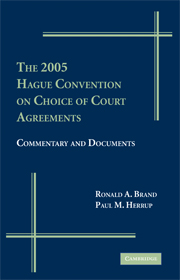Book contents
- Frontmatter
- Contents
- Preface
- PART I A BASIC INTRODUCTION TO THE 2005 HAGUE CHOICE OF COURT CONVENTION
- 1 The Context and History of the Hague Negotiations
- 2 The Convention Structure and Content
- 3 Interpretation and Use of the Convention
- PART II ARTICLE-BY-ARTICLE COMMENTARY ON THE CONVENTION
- PART III CHOICE OF COURT IN THE ABSENCE OF A MULTILATERAL CONVENTION
- PART IV LITIGATION AND ARBITRATION CHOICES AFTER THE HAGUE CONVENTION
- Appendix A Explanatory Report by Trevor Hartley & Masato Dogauchi (including the text of the 2005 Hague Convention on Choice of Court Agreements)
- Appendix B Cited Excerpts from the Nygh-Pocar Report
- Index
2 - The Convention Structure and Content
from PART I - A BASIC INTRODUCTION TO THE 2005 HAGUE CHOICE OF COURT CONVENTION
Published online by Cambridge University Press: 26 October 2009
- Frontmatter
- Contents
- Preface
- PART I A BASIC INTRODUCTION TO THE 2005 HAGUE CHOICE OF COURT CONVENTION
- 1 The Context and History of the Hague Negotiations
- 2 The Convention Structure and Content
- 3 Interpretation and Use of the Convention
- PART II ARTICLE-BY-ARTICLE COMMENTARY ON THE CONVENTION
- PART III CHOICE OF COURT IN THE ABSENCE OF A MULTILATERAL CONVENTION
- PART IV LITIGATION AND ARBITRATION CHOICES AFTER THE HAGUE CONVENTION
- Appendix A Explanatory Report by Trevor Hartley & Masato Dogauchi (including the text of the 2005 Hague Convention on Choice of Court Agreements)
- Appendix B Cited Excerpts from the Nygh-Pocar Report
- Index
Summary
INTRODUCTION
This chapter provides a brief introduction to the Convention. It is not meant to be a substitute for the more detailed analysis that follows, but rather an effort to provide in one place a basic overview of the Convention's purpose, scope of application, and basic rules, and to facilitate a general understanding of the Convention.
THE THREE BASIC RULES
The Hague Convention on Choice of Court Agreements provides rules giving effect to choice of court agreements and for recognizing and enforcing the resulting judgments. These objectives are accomplished in the Convention primarily through three basic rules found in Articles 5, 6, and 8.
ARTICLE 5: THE CHOSEN COURT SHALL HAVE JURISDICTION
Article 5(1) of the Convention provides the basic rule that “[t]he court or courts of a Contracting State designated in an exclusive choice of court agreement shall have jurisdiction to decide a dispute to which the agreement applies, unless the agreement is null and void under the law of that State.” In this rather simply stated provision, the Convention provides both the basic rule of jurisdiction applicable in the chosen court and the major general qualification to that rule. The rule itself is a reflection of respect for party autonomy and the desire to provide predictability in commercial and other relationships of a private nature. As a general proposition, if the parties in an exclusive choice of court agreement select a specific court located in a Contracting State for purposes of adjudicating their disputes, that court shall have jurisdiction.
- Type
- Chapter
- Information
- The 2005 Hague Convention on Choice of Court AgreementsCommentary and Documents, pp. 11 - 25Publisher: Cambridge University PressPrint publication year: 2008



